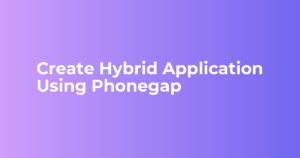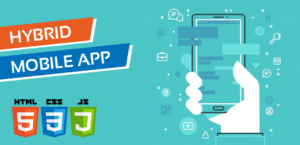
Business Enterprises today are primarily aiming to target a large customer base. So, with that intention in mind, they are focusing on both Android and iOS users. They want a mobile or web application that can run seamlessly on multiple platforms.
Earlier, mobile porting from one platform to another was a difficult and expensive affair until hybrid application development came into the picture. It has simplified the job of the developers with flexible and smooth coding. But the question is which is the best cross-platform application? The answer is PhoneGap.
Why PhoneGap is an Ideal Choice for Hybrid App
PhoneGap is a Reliable Platform
PhoneGap is a highly reliable platform and easily compatible with different mobile application Operating Systems. It supports all major platforms apart from iOS and Android such as Windows, Blackberry, WebOS, Tizen, and Bada.
Cost-Efficient Option
For clients with a tight budget in hand, the PhoneGap could be a viable option. The developers have to write a single code and program to run an application on different platforms.
Has a Large Community Base
PhoneGap offers developers extensive support from a large community of developers worldwide, which is constantly growing. So, if the developer faces any problem, he can clarify the doubt by taking the help of the experienced developers. Besides that, they also get the support of a large number of libraries and frameworks.
Easy to Learn
For building a cross-development application in PhoneGap, you only need to have the knowledge of CSS, HTML, and JavaScript.
Strong Backend Support
PhoneGap also has strong backend support that accelerates the development process and reduces the efforts of the developers. It is also a user-friendly language for first-time developers.
Improved UI Libraries and User Interface
The PhoneGap has highly improved UI libraries along with User Interface, which provides a better experience to the users while they are viewing the pages.

Let’s have a view on some of the most important stats based on PhoneGap provided by iDatalabs-
- PhoneGap has a market share of about 21.93%, which is second after jQuery with a market share of 30.56%.
- Computer Software Industry (24%) is the top customer of PhoneGap, followed by Information Technology Solutions (16)%.
- If we look region-wise, the US (37%) tops in implementing PhoneGap for its projects while India is following it with 10%.
Role of HTML5, CSS, and JavaScript in Mobile App Development
It is important to understand the role of HTML5, CSS, and JavaScript in developing a mobile application. HTML5 and CSS play an essential role in providing the mobile-friendly user experience. The developers can make use of useful libraries such as Phaser to create best-in-class gaming apps and appealing graphics. Apart from that, other handy libraries like Paper.js and Processing.js help to integrate vector graphics and animations. JavaScript can help in enabling touch-optimized functionality and interactivity.
Building a Hybrid App Using PhoneGap
The developers are employing HTML/CSS and JavaScript to create a hybrid application using PhoneGap for Android, iOS, and Windows platforms. This has allowed the app to work as a native application through it and is built with web scripts such as HTML5 and JavaScript. As such, there is not much of a difference in the mobile development approach and the apps get access to native device APIs. The fact that both the Apple App Store and Google Play Store help in packaging and distributing apps offers an additional advantage.
The Entire Process of Creating a Hybrid App with PhoneGap has been categorized into four steps to simplify the understanding of the developers.
The App Designing
This is supposed to be the first phase of the project where you are usually involved with developing the wireframes or initial designs. You may use Adobe Photoshop or any other similar graphic design software to create a prototype of the application. Your aim should be to develop a basic functionality of the application, which can define the purpose of app development from a user’s perspective.
The App Coding
The installation and configuration of the PhoneGap development primarily depend on the type of platform you are choosing. For instance, if you are targeting iOS, then download and install Xcode apart from iOS Software Development Kit (SDK). This will provide an indication that you have logged in for the Apple Development Program. You also need to have proper access to the developer portal.
But if you are rooting for the Android platform, then you have to download the Eclipse IDE. After the installation of both IDE and PhoneGap, you need to follow the same process of coding as in the case of building a standard web application. As such, the PhoneGap develops a self-explanatory folder structure, whereas the www folder is the root directory for the web app.
You can store the CSS images and JavaScript libraries in their respective folders under assets. Also, there is no need to follow the entire setup but only employ the PhoneGap platform. Thus, it can be said that the coding procedure is almost the same as in the case of a standard web application. The only difference is that the compilation is done on the cloud instead of the computer.
The App Testing
What follows next after app coding is the testing and debugging process. Here you can use either the iOS simulator with Xcode or employ Ripple PhoneGap Emulator. Again, this will depend on which operating system you are choosing. If you are installing the PhoneGap in your system, the code should be uploaded to PhoneGap Build, which is a cloud-based compilation service. PhoneGap accepts the HTML5, CSS, and JavaScript files of the application, which means that your app is ready to be tested. You have to install the app on any physical device so as to test the application.
The App Distribution
Once you have tested the app and are satisfied with its performance, it’s time to move on to the app distribution. Yet again, the type of operating system becomes an important factor The app distribution task gets simplified with PhoneGap. You just need to be informed about the developer’s credentials and security while Build will look after the rest of the things. The app gets ready to be uploaded into the app store.
The Final Words
PhoneGap is a viable platform allowing developers to create outstanding hybrid applications. What’s interesting to note is that the developers don’t have to root for the traditional programming languages such as Java or Objective C. Moreover, the use of HTML5 simplifies the development process and curtails the efforts and time of the developer.
If you are looking for an experienced PhoneGap Development Company to build your hybrid apps at affordable prices, you are in the right place.


